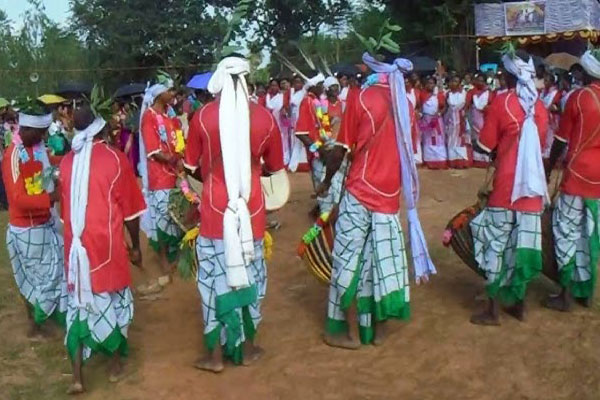
This is a dance of indigenous women. They performed their song with various instruments. No one man engaged this dance

The festival begins on the fifth day of the month of Ashwin. On this day, dance songs are sung in remembrance of Mahishasur. There is sorrow in the melody of the song. Rhythmic songs are occasionally sung by artists. Now, of course, this festival starts from the beginning of Durgapuja. The men express their grief by dancing in different villages. They could not accept the fact that he was killed,so this time their dance songs were performed in a mournful atmosphere. This Dasai festival lasts for three days.
Atter being tired from working all day, the people of the indigenous community tind some peace in this lagarey dance at night. This dance lasts till night. However, with the change of time, some people inform that this dance can no longer be seen in that way. Some people think that if there is no rain in the sky, then rain is invited through this lagarey dance.
Dang is a group dance pertormed by Santhal tribes during all special festivals and occasions. This dance not only reveals the culture or traditions of the local tribes but also showcases the strength of unity. Dances are usually performed on a marriage ceremony of the tribes and are connected with the celebration of certain rituals. The dancers stand in a line holding hands move to the rhythm of the Madol.

It is performed on the occasion of Chaitra Sankranti. After Karam Pujo , Patanach is performed all night long. It is like Saharai.

This is the dance of men and women. This deity, the god of wealth, cut the branches of a karam tree and used it to serve unmarried men and women through Naikaybaba . In this festival, their gurubaba keeps the people awake all night long in their own tune. The next day the Karam tree is floated through the dance song. However, no other dance can be shown until the Karam tree is floated. But later any dance song is done.
Before sowing the seeds, they worshipped through Naikay baba to please the deity. Here, too, the worship of the ancestors is performed according to gramsholoana. It is known that the tribal people worship this pujo to get good wealth. In the same way they worship Marangburu, Jaher Aao, Morek turuik.
This festival is celebrated to please the Gods for harvesting from the field. There are also rules of worship for ancestors. It is offered to the deities by making it cake with fresh new rice dust of new paddy grown from the field. This Ero-sim is celebrated in the month of Agrahayan. It is a harvest festival.
Many people call it Shalui Puja in Bengali. In the month of Chaitra, the beauty of nature blossoms in the forest. The whole forest becomes green. Atter the traditional dress, they offer new tlowers to the gods. Indigenous men and women dance together at this timeThe festival is celebrated through dance and songs. This festival is also seen by many asa festival of liveliness.
The arrival of the new year. Indigenous people celebrate this festival in the month of Magh. Forest shals and molasses trees are worshiped as deities. Shals and moles tlowers are essential in this pujo. Many also think that it is basically a celebration of village head election. The 'Panchajan' system is a major part of this festival. Many are also saying that their referendum will actually be decided through worship. In fact,through this festival, it is decided who will be responsible for the management of the village. From that point of view, the importance of this festival is enough.